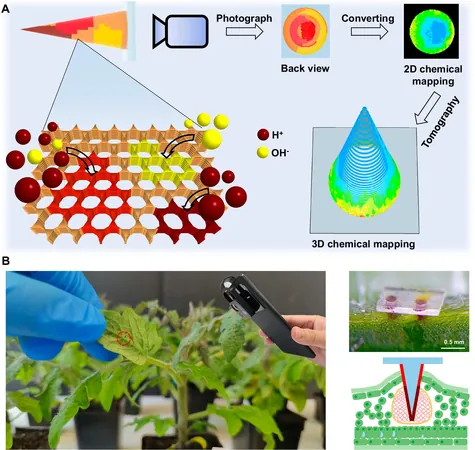
Groundbreaking Sensors Promise to Revolutionize Plant Dehydration Detection
2024-11-25
Author: Wei Ling
Introduction
Have you ever been uncertain about whether your beloved plants are thirsty or overly watered? Soon, both amateur gardeners and seasoned farmers will have an innovative solution at their fingertips. Researchers have made significant strides in developing sensors capable of detecting the hydration levels in plants, promising real-time insights into their health.
Collaborative Innovation
A collaborative effort led by the Singapore-MIT Alliance for Research and Technology (SMART)—alongside Temasek Life Sciences Laboratory and the Massachusetts Institute of Technology—has birthed an astonishing new sensor technology. This invention operates by monitoring pH changes in living plants, a telltale sign of drought stress, enabling early detection that could prevent dire yield losses.
Covalent Organic Framework Sensors
The game-changing sensors, known as Covalent Organic Framework (COF) sensors, utilize silk fibroin (SF) microneedles for direct measurement within plant tissues. This innovative system can identify shifts in acidity within plant xylem tissues 48 hours prior to conventional detection methods, allowing for timely intervention.
The Impact of Drought Stress
Drought stress, caused by insufficient water supply, poses a significant threat to agricultural yield. As a major factor affecting plant metabolism, drought can shrink leaf size, hinder root development, and lead to wilting and plant death if not addressed promptly. As climate change intensifies and agricultural challenges become more pronounced, farmers often find themselves ill-equipped to act before damage occurs. This newfound sensor technology aims to bridge that gap.
Practical Application
Professor Michael Strano, a key figure in this groundbreaking research, stresses the practicality of these sensors: "They can be easily attached to plants and utilized with simple instrumentation. This empowers both farmers and researchers to leverage powerful analytical tools."
Technical Advancements
The COF sensors represent a solution to a long-standing hurdle in the agricultural field, as previous COF-based sensors could not effectively interact with the biological tissues they aim to monitor. COFs are essentially networks of organic molecules that exhibit color changes depending on pH levels, allowing them to serve as indicators of plant health.
Transforming Plant Monitoring
This method transforms our ability to monitor plant physiology, making it possible to catch signs of stress early through pH analysis. With the mounting pressures of climate change, this technology could be a boon for optimizing crop production, delivering crucial insights into plant health and resilience.
Publication in Nature Communications
In their recent publication in *Nature Communications*, the researchers detail their pioneering work, which includes the remarkable capacity for in-vivo 3D mapping of pH levels using just a smartphone camera. This approach is not only minimally invasive but also provides a faster alternative to traditional methods that tend to be slower and more disruptive.
Design and Functionality of COF Compounds
The team has successfully designed four COF compounds that alter color based on changes in acidity, seamlessly combining them with transparent SF microneedles. This innovation allows for real-time visualization of pH levels within plant tissues, with color transitions indicating varying hydration statuses.
Professor's Insights
Dr. Song Wang, one of the lead researchers, stated, "When utilized in plants, these COF compounds will change from dark red to red as the pH levels increase in the xylem, signaling potential drought stress and the urgent need for water."
Microneedle Advantages
Dr. Yangyang Han adds, "These microneedles are sturdy and designed to maintain stability, offering a cutting-edge tool for farmers. The transparency and robustness facilitate multidimensional mapping without damaging the plant."
Future Aspirations
Looking ahead, the researchers envision further advancements in COF-SF microneedle technology, planning to expand its capabilities beyond mere pH detection to include a variety of biologically significant compounds such as plant hormones and metabolites. This ambitious evolution could ultimately redefine how we understand and manage plant health in an increasingly unpredictable climate.
Conclusion
With these groundbreaking developments in sensor technology, the future of agriculture may shift dramatically, ensuring better plant care and increased food security for a growing global population.


 Brasil (PT)
Brasil (PT)
 Canada (EN)
Canada (EN)
 Chile (ES)
Chile (ES)
 España (ES)
España (ES)
 France (FR)
France (FR)
 Hong Kong (EN)
Hong Kong (EN)
 Italia (IT)
Italia (IT)
 日本 (JA)
日本 (JA)
 Magyarország (HU)
Magyarország (HU)
 Norge (NO)
Norge (NO)
 Polska (PL)
Polska (PL)
 Schweiz (DE)
Schweiz (DE)
 Singapore (EN)
Singapore (EN)
 Sverige (SV)
Sverige (SV)
 Suomi (FI)
Suomi (FI)
 Türkiye (TR)
Türkiye (TR)